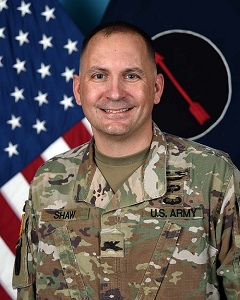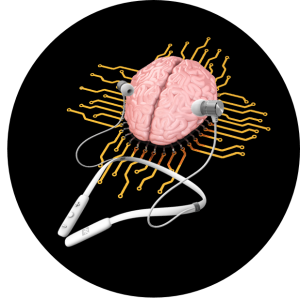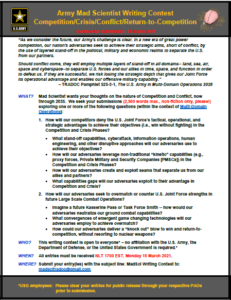[Editor’s Note: Mad Scientist is pleased to announce our latest episode of “The Convergence” podcast, featuring COL Scott Shaw, Commander, U.S. Army Asymmetric Warfare Group, discussing the future of ground warfare, including lessons learned from the Nagorno-Karabakh Conflict in 2020 and the realities of combat for tomorrow’s Soldiers. Competition and Conflict will feature advanced engagement battlespaces and “Hyperactive Battlefields” — “What we consider to be a rapid pace may be a snail’s pace in five years.” The U.S. Army must rapidly adapt how we organize, train, and lead our Soldiers to outcompete and win against all potential adversaries. Please note that this podcast and several of the embedded links below are best accessed via a non-DoD network due to network priorities for teleworking — Enjoy!]
[If the podcast dashboard is not rendering correctly for you, please click here to listen to the podcast]
 COL Scott Shaw commands the Asymmetric Warfare Group (AWG), whose mission is to provide global operational advisory support to U.S. Army forces to rapidly transfer current threat based observations and solutions to tactical and operational commanders in order to defeat emerging asymmetric threats and enhance multi-domain effectiveness.
COL Scott Shaw commands the Asymmetric Warfare Group (AWG), whose mission is to provide global operational advisory support to U.S. Army forces to rapidly transfer current threat based observations and solutions to tactical and operational commanders in order to defeat emerging asymmetric threats and enhance multi-domain effectiveness.
In today’s podcast, COL Shaw discusses the future of ground warfare and the realities of combat for tomorrow’s Soldiers. The following bullet points highlight key insights from our interview with him:
-
-
- AWG was developed to promote U.S. Army understanding of asymmetric threats. Today, this effort is focused in three research areas: the operations and information environment, electronic warfare, and countering unmanned systems.
-
-
-
- The United States needs to balance focus, spending, and training among threats from China, Russia, Iran, North Korea, and violent extremist organizations (VEOs). Strategists need to remember that “the enemy gets a vote,” and thus efforts will need to remain adaptable.
-
-
-
- While the United States excels at fighting at a Brigade Combat Team-level, future success will stem from excellence in space and cyber operations, electronic warfare, air defense, information operations, and lean logistical planning. These areas are challenging and will require extensive organization and advanced exercise design.
-
-
-
- The use of unmanned aerial systems (UAS) for reconnaissance and targeting will increase. As these systems proliferate, they will lower the ‘entry fee’ into combined arms operations, granting even non-state actors a localized air force and creating a general environment of fear.
-
-
-
- Development of sensing technologies has made it increasingly challenging to hide. When combined with developments in artificial intelligence (AI) that will increase the tempo of warfare, it is likely that survivability moves will be required near-constantly.
-
-
-
- Information operations, including the use of misleading videos and ubiquitous attack surfaces, will create a chaotic operational environment. Leaders will be required to quickly discern the truth in order to make decisions, while simultaneously attempting to interfere with the decision cycles of adversaries.
-
-
-
- U.S. Soldiers and Leaders are the United States’ greatest asymmetric advantage. In the future, training will need to be adapted to ensure forces are comfortable operating dispersed and with less constant communication.
-

Stay tuned to the Mad Scientist Laboratory for our next episode of “The Convergence,” featuring an interview with Cathy Hackl — Futurist and Founder of Futures Intelligence Group, one of LinkedIn’s Top Tech Voices, and the host of the Future Insiders podcast — discussing forecasting, the future of augmented and virtual reality, and women in tech on 18 March 2021!
If you enjoyed this post, check out the following related topics:
Our Insights from the Robotics and Autonomy Series of Virtual Events, associated webinars’ content (presenter biographies, slide decks, and notes), and watch the associated videos [via a non-DoD network]
Both our Weaponized Information: What We’ve Learned So Far… and Insights from the Mad Scientist Weaponized Information Series of Virtual Events, as well as the associated webinars’ and conference content, and watch all of the associated videos [via a non-DoD network]
Explore the Operational Environment’s breadth and complexity in the near, mid-, and far terms:
Four Models of the Post-COVID World, The Operational Environment: Now through 2028, and The 2 + 3 Threat video
The Future Operational Environment: The Four Worlds of 2035-2050, the complete AFC Pamphlet 525-2, Future Operational Environment: Forging the Future in an Uncertain World 2035-2050, and associated video
See what we’ve learned about the Character of Warfare 2035
Drill down further regarding our 2+3 Threats:
Russia: Our Current Pacing Threat
China: Our Emergent Pacing Threat
The Iranian Pursuit of Military Advantage: A Forecast for the Next Seven Years, The Hermit Kingdom in the Digital Era: Implications of the North Korean Problem for the SOF Community, and Extremism on the Horizon: The Challenges of VEO Innovation by Colonel Montgomery Erfourth and Dr. Aaron Bazin
>>> REMINDER: Our Mad Scientist Writing Contest on Competition, Crisis, Conflict, and Change seeks to crowdsource the intellect of the Nation (i.e., You!) regarding:

How will our competitors deny the U.S. Joint Force’s tactical, operational, and strategic advantages to achieve their objectives (i.e., win without fighting) in the Competition and Crisis Phases?
How will our adversaries seek to overmatch or counter U.S. Joint Force strengths in future Large Scale Combat Operations?
Review the submission guidelines on our contest flyer, then get cracking brainstorming and crafting your innovative and insightful visions — you’ve got 11 days left — deadline for submission is 15 March 2021!!!



